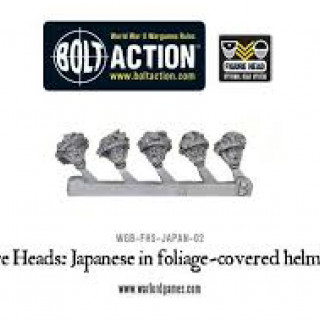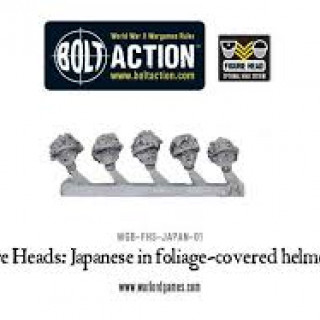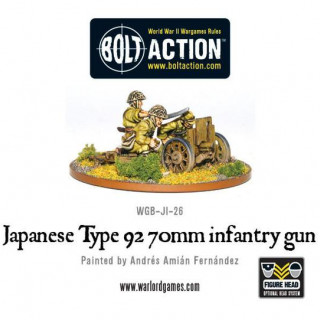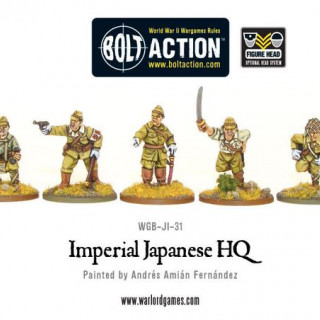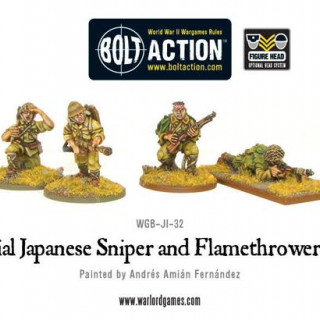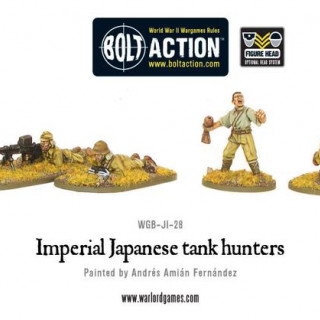
Japanese Infantry WW2 28mm
Recommendations: 6
About the Project
Building Japanese Imperial Infantry force for Chain of Command and Bolt Action
Related Game: Chain of Command
Related Company: Too Fat Lardies
Related Genre: Historical
This Project is Active
Figures
2 Boxes of Bolt Action Japanese Infantry plus 3 additional sprues (total of 13 Sprues) for a total of 78 Figures.
Plus 2 additional head sets for variety
For my companion Project Blog on British & Commonwealth forces click here
Historical Context:
Lacking the industrial resources to field large numbers of tanks or artillery, the Imperial Japanese Army of World War II relied on its infantry to provide its striking power. The Japanese foot soldier was expected to overcome his emperor’s enemies through superior training, physical conditioning and most of all through superior will. The early years of the China Incident seemed to confirm this path. But patriotism and devotion to the emperor could only do so much to offset the massive firepower advantage that Soviet, British and especially American troops could bring to bear.
Each rifle company had three platoons, with each platoon counting 44 riflemen, three light machine guns and three 50mm grenade dischargers, the unique weapon known to the allies as the “knee mortar.”
Each battalion had four rifle companies
The battalion’s heavy weapons company only had two platoons each of four heavy machine guns, and no mortars. Instead, fire support came from a pair of Type 92 70mm infantry guns; later in the war two 37mm anti-tank guns would be added to many battalions. Because of the lack of motor vehicles, Japanese infantry units also had an inordinately large number of men detailed to haul ammunition.
Little more support could be expected at the regimental level. The Japanese infantry regiment counted three infantry battalions, a regimental cannon company with four 75mm guns and an anti-tank company with four or six 37mm guns. The division controlled engineer and reconnaissance battalions (styled “regiments”) and would often attach assets for special operations, not only from these battalions but even rifle companies from other regiments.
Chain of Command:
Using 75 of the 78 figures
Japanese Rifle Platoon: (51 men)
Command Team: (2 men)
Rikugun Shō‐i (Second Lieutenant) or Rikugun Chū‐i (First Lieutenant), Senior Leader, with pistol and sword
Gunsō (Sergeant), Senior Leader, with rifle
GRENADE DISCHARGER SQUAD: (13 Men)
Corporal, Junior Leader, with rifle
MORTAR TEAM 1
One Type 89 Grenade Launcher with Four crew
MORTAR TEAM 2
One Type 89 Grenade Launcher with Four crew
MORTAR TEAM 1
One Type 89 Grenade Launcher with Four crew
SQUADS ONE: (12 men)
Corporal, Junior Leader, with rifle
LMG SQUAD
One LMG with three crew
Nine riflemen
SQUADS TWO: (12 men)
Corporal, Junior Leader, with rifle
LMG SQUAD
One LMG with three crew
Nine riflemen
SQUAD THREE:(12 men)
Corporal, Junior Leader, with rifle
LMG SQUAD
One LMG with three crew
Nine riflemen
Plus Support Units
LIST ONE:
Entrenched Regular Infantry Squad with Junior Leader (12 men)
Corporal, Junior Leader, with rifle
LMG SQUAD
One LMG with three crew
Nine riflemen
LIST FOUR:
Regular Infantry Squad with Junior Leader (12 men)
Corporal, Junior Leader, with rifle
LMG SQUAD
One LMG with three crew
Nine riflemen
Chain of Command Support Options:
LIST ONE
Engineer Mine Clearance Team, 3 men
Engineer Wire Cutting Team, 3 men
Engineer Demolition Team, 3 men
Satchel charge
Minefield
Barbed Wire
Rifle grenade launcher Type 100
Entrenchments for one Team infantry or support weapon (Choose twice for Squad)
LIST TWO
Roadblock
Tank Killer Team, 2 men
Pre‐Game Barrage
Ruse
LIST THREE
Engineer Flamethrower Team, 3 men
Sniper Team
Type 92 MMG on tripod mount
20mm Type 97 AT rifle Team, 5 men
Type 95 Ha Go tank with Junior Leader
‘Osaka’ M92 armoured car with Junior Leader
LIST FOUR
Engineer Section with Junior Leader
Regular Infantry Section with Junior Leader
Forward Observer and 7.5cm Type 41 infantry gun battery
7cm Type 92 infantry gun with Junior Leader and five crew
3.7cm Type 94 Anti‐Tank gun with five crew and Junior Leader
Type 89 Chi‐Ro tank with Junior Leader
Type 97 Chi‐Ha tank with Junior Leader
Type 92 combat car with Junior Leader
Type 89 Vickers‐Crossley armoured car with Junior Leader
Wishlist:









































